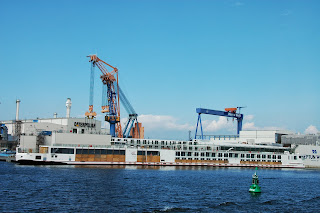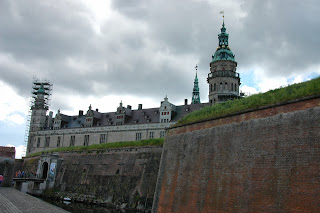We arrived at Warnemunde (North Germany)
after a much needed rest with a day at sea. We were moored at the entrance to
the river/harbour and were in the thick of the traffic. The cross river ferry
had to manipulate around QV’s bow and time their crossing between international
ferries.
Many of the team took off to Lubceck which
we visited last year (see July 2012 blog) so this time we opted for a trip to Rostock.
This was in four parts – a brief coach ride to the tram terminus where we
boarded a tram.
The tram took us through Rostock and we
quickly got a feel for the place. Religious converts are in decline so even the
high church and its roof space has been converted into units. Apparently this is a lofty conversion.
Our third mode of transport was on foot and
included a visit to St Mary’s church which houses an amazing astrological
clock. It covers the period from the 14thC through to 2017 and is the oldest working
clock in Europe. Apart from the alignment of stars and resultant information it
also tells normal time, day, month and year. With the clock “running out” in
2017 an elderly professor has used the old astrological methods to design a new
disc. He also set a group of his brighter students the challenge of using
computers to undertake the design of the new disc. Thankfully both these stars
aligned and the new disc can now be built.
Much
of Rostock was destroyed during the war and the buildings now on display are
largely copies of the original buildings. One of the buildings that survived
shows the detailed baroque brickwork that exists in some parts. The bricks included
a variety of shapes with some also glazed - an intricate design which would certainly challenge your average brickie.
By contrast a recent building has a simple
shape and façade. However, as with much architecture this had caused some controversy.
The result is a sculpture has been added to the roof which is said to be of the
architect so that he can consider what he has done and presumably jump if needs
be.
The fourth mode of transport back to the
ships was a canal boat (including beer and nibbles). They make the large river
cruisers in Warnemunde. This one has been completed and has had plywood added
to protect the windows while it travels across the Baltic and other seas to its
destination.
Liebherr the crane manufacturer is also
based here as is a company building the bases for marine located wind towers.
There is a lot more structure below the water level than above.
All this engineering was a bit too much for
the girls who were happier drinking and giggling.
The next day saw us in Copenhagen where we
opted for a visit to “Fairy tale castles”. A bit of a misnomer with Kronberg
Castle (or Slot as they are known locally) which guards the narrow Sound
between Denmark and Sweden. This was built in order to derive taxes from
shipping passing through the straights (now 30,000 vessels pa). If you did not
pay then cannon were set off. Due to references in his writings it appears that
Shakespeare may have visited and hence the more romantic name of Hamlet castle
is sometimes used.
We also visited the Summer palace which is
often inhabited by the Crown Prince Frederik, his Australian wife Mary and their
four children. Much more detail is available from our in-house Royalist Helen.
Lunch was a local spread including pickled
herrings (three varieties). What was a little unexpected is that we dined at a
retirement village. (This was not a marketing exercise as only Danes can live
here and only those who have to have been out of the country for at least 2 years.
There is also a waiting list.)
The design of the village was unusual with
each unit being well lit with plenty of South facing windows over their own
courtyard but very few windows to common areas. (The village was one of the
first designs by John Utzon who went onto design the Sydney opera house and the Kuwait parliament building.) As a result
the common backyard was very private, spacious and quite with only the faint
noise of club on ball from the golf course that ran along the valley beyond.
(OK there was also the occasional “fore” and whatever the Danish equivalent of “dam”
is - I am mindful that this blog is also read by children.)
The final
Slot was Frederiksborg. We approached via the spectacular gardens where not a
blade was out of place.
The other side of the slot is Neptune’s
Fountain. It is a really elaborate affair but is almost insignificant against
the background of the Slot and its copper roofs and ornate brickwork.
What was striking about this castle is that
it is also contains current day decorations. In the great hall there were coats
of arms everywhere. The latest were in one alcove. This is one designed for
John Donaldson (you know - Mary’s old man).
By contrast this is the oldest working transportable
organ in Europe and was built in 1610. The bellows are operated by pull cords
on the right hand structure where the rectangular panels open and close. It was built be a craftsman called Compenius, has 1001
pipes made from various rare woods and breaks down into components for easy
transport and has been played in a variety of churches and cathedrals.
Some
of the paintings are quite realistic albeit inevitably with a battle focus – this is dated
1883.
By contrast
this is a more contemporary painting showing Queen Mary, with Crown Prince
Frederik and first son Christian. In Denmark the Kings names alternate between
Frederik and Christian which is in stark contrast to England and all the hype
surrounding Kate’s recent child – no business for bookmakers here.
Finally just to prove we were in Copenhagen….





















No comments:
Post a Comment